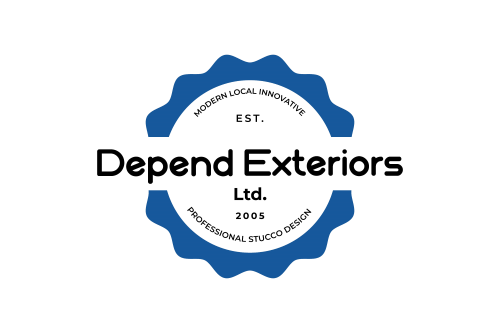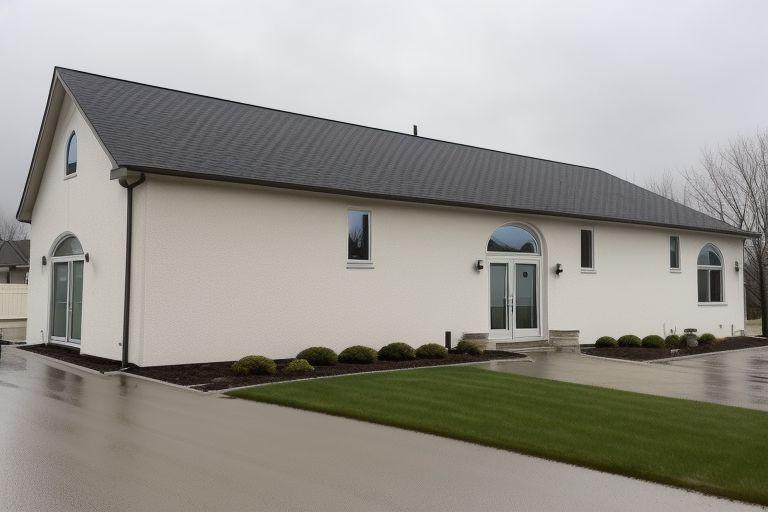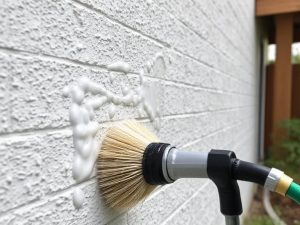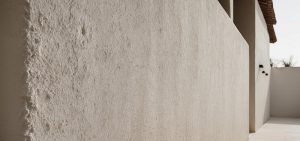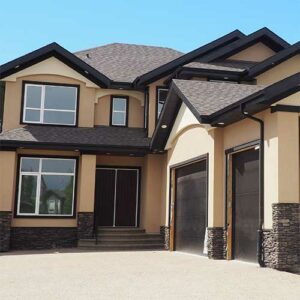Life Expectancy of EIFS
The life expectancy of EIFS (Exterior Insulation and Finish Systems) ranges from 30 to 60 years, depending on several factors. Also, different EIFS systems vary in lifespan due to material composition, drainage capabilities, and impact resistance.
In this guide, we’ll cover:
- What Is the Life Expectancy of EIFS? – Understanding how long EIFS lasts under different conditions.
- Lifespan of Different Types of EIFS – Exploring various EIFS systems.
- Factors That Affect EIFS Longevity – How installation, maintenance, material quality, climate, and impact exposure influence EIFS lifespan.
- FAQs – Answers to common EIFS-related concerns, such as moisture issues and cracking.
Keep reading to learn how to maximize the longevity of EIFS and ensure your investment remains durable and visually appealing for decades!
If you have more questions or need EIFS services in Edmonton, AB, call (780) 710-3972.
What Is the Life Expectancy of EIFS?
The life expectancy of EIFS is 30 to 60 years, depending on installation and maintenance. The system is designed to withstand environmental conditions, but several external and internal factors influence its durability. Modern EIFS systems with drainage layers and high-quality materials tend to last on the higher end of this range.
- Standard EIFS Life Expectancy: 30–50 years
- EIFS with Proper Maintenance & Drainage System: 50–60 years
- Poorly Installed or Neglected EIFS: 15–25 years (due to moisture retention and damage)
Lifespan of Different Types of EIFS
EIFS comes in different configurations, and the type of system used significantly impacts its durability. Below is an overview of the various types of EIFS and their expected lifespan.
1. Barrier EIFS (Traditional EIFS)
Lifespan: 20–40 years (with proper maintenance)
Barrier EIFS was the first generation of EIFS and is designed to keep water out using a single protective layer. However, this system has no drainage mechanism, meaning any water that infiltrates remains trapped behind the system. If moisture builds up, it can lead to mould, rot, and early failure.
✅ Ways to Extend Barrier EIFS Lifespan:
- Apply high-quality sealants around openings and penetrations to prevent water entry.
- Conduct frequent inspections to identify and fix minor cracks early.
- Consider upgrading to a drainage EIFS system to avoid water retention issues.
2. Drainage EIFS (Modern EIFS with Moisture Management)
Lifespan: 40–60 years (with proper installation and upkeep)
Drainage EIFS is an improved version of traditional EIFS, incorporating a water-resistant barrier and a drainage cavity to allow moisture to escape. This design significantly reduces the risk of trapped moisture and extends the system’s lifespan.
✅ How to Maximize the Lifespan of Drainage EIFS:
- Ensure proper installation with a fully functioning drainage plane.
- Regularly clean and inspect weep holes to prevent blockages.
- Use high-impact mesh in areas prone to physical damage.
3. Polymer-Based EIFS (Acrylic-Based Finishes)
Lifespan: 45–60 years (with maintenance)
Polymer-based EIFS uses acrylic coatings that provide superior UV protection, flexibility, and moisture resistance. It is less prone to cracking compared to traditional EIFS, as the acrylic finish allows for movement due to temperature changes.
✅ How to Enhance Polymer-Based EIFS Lifespan:
- Use high-quality acrylic finishes to resist fading and chalking.
- Recoat the surface every 10–15 years to maintain aesthetics and durability.
- Ensure proper drainage behind the system to prevent water retention.
4. High-Impact EIFS (Enhanced Durability System)
Lifespan: Over 50 years (with proper care)
High-impact EIFS is designed for commercial and industrial applications, incorporating multiple layers of reinforcement mesh to resist physical damage. This system is ideal for areas with high traffic or potential impact from equipment, vehicles, or severe weather conditions.
✅ Ways to Maintain High-Impact EIFS:
- Install in high-wear areas, such as ground floors and entryways.
- Apply extra layers of base coat for added strength.
- Conduct annual structural inspections to ensure system integrity.
5. Polymer-Modified EIFS (PM EIFS)
Lifespan: Over 50 years (with consistent upkeep)
Polymer-modified EIFS (PM EIFS) is designed to be stronger and more impact-resistant than traditional EIFS. It includes cementitious components, making it more durable while maintaining the benefits of EIFS insulation.
✅ How to Extend the Life of PM EIFS:
- Use reinforced polymer coatings to increase flexibility and resistance.
- Ensure proper waterproofing layers to protect against moisture.
- Schedule routine inspections for any wear or surface damage.
6. Prefabricated EIFS Panels
Lifespan: Over 50 years (with controlled installation conditions)
Prefabricated EIFS panels are factory-assembled and delivered to the site for easy installation. This method reduces on-site errors, enhances consistency, and provides a highly controlled installation process, making it one of the longest-lasting EIFS solutions.
✅ Best Practices for Prefabricated EIFS Panels:
- Install with precision to ensure seamless joints and waterproofing.
- Conduct factory testing before installation to check for quality consistency.
- Perform scheduled cleaning and maintenance to prevent surface degradation.
Factors That Affect EIFS Longevity
Factors that affect your EIFS longevity include:
1. Quality of Installation
EIFS must be properly installed to achieve its full lifespan. Errors such as insufficient adhesive, improper flashing, lack of a drainage system, or poor substrate preparation can cause early failure. Incorrectly applied EIFS can lead to water penetration, detachment, and structural weaknesses.
✅ How to Ensure Longevity:
- Hire our certified EIFS professionals with proven expertise.
- Ensure a drainage system is used to prevent moisture retention.
- Properly install flashing, sealants, and expansion joints to avoid cracking.
- Conduct post-installation moisture testing to check for vulnerabilities.
2. Maintenance and Inspection
Regular maintenance extends the life of EIFS by preventing moisture damage, cracking, and surface wear. Ignoring minor issues can lead to bigger structural failures that reduce the system’s lifespan.
✅ Maintenance Best Practices:
- Inspect EIFS annually for cracks, dents, or discoloration.
- Re-seal joints and caulking every 5–10 years to prevent water intrusion.
- Wash EIFS surfaces with mild detergent and low-pressure water to remove dirt and biological growth.
- Repair minor cracks immediately before they expand and allow moisture in.
- Check for separating or bulging sections that may indicate hidden damage.
3. Material Quality and Composition
The quality of EIFS materials significantly affects how long they last. Modern EIFS products are designed with improved coatings, impact-resistant mesh, and advanced drainage layers, making them more durable than earlier versions.
✅ Key Material Factors:
- Use high-quality, manufacturer-approved EIFS components.
- Opt for impact-resistant mesh in high-risk areas.
- Ensure proper base coat thickness to enhance durability.
- Choose moisture-resistant coatings to prevent water damage.
4. Climate and Environmental Exposure
EIFS performs well in most climates, but harsh weather conditions can impact its longevity.
🌡️ How Weather Affects EIFS:
- Extreme Temperature Changes – Freeze-thaw cycles can cause expansion and contraction, leading to cracks.
- High Humidity & Rainfall – Increases the risk of water infiltration if EIFS lacks a proper drainage system.
- Hailstorms & High Winds – Can cause impact damage, leading to holes or cracks that allow moisture entry.
- Prolonged Sun Exposure – UV rays can slowly degrade EIFS coatings if not properly protected.
✅ Weather Protection Tips:
- Install EIFS with a drainage system in wet climates.
- Use high-impact mesh in hail-prone areas to reduce damage.
- Conduct seasonal inspections to check for cracks or moisture issues.
- Apply UV-protective coatings in regions with excessive sun exposure.
5. Impact Damage and Repairs
EIFS is lightweight and durable, but it is not as impact-resistant as brick or stone. Ladders, tools, hail, or vehicles can dent or puncture the surface, shortening its lifespan.
✅ How to Prevent Impact Damage:
- Install protective barriers in high-traffic areas.
- Use impact-resistant EIFS mesh in vulnerable locations.
- Repair any dents or holes immediately to prevent water infiltration.
- Avoid leaning heavy objects against EIFS walls.
6. Mold and Moisture Control
One of the biggest threats to EIFS longevity is moisture retention. Older EIFS systems (before the 2000s) were designed as barrier systems, meaning they did not have built-in drainage. If water gets behind the system, it cannot escape, leading to mould growth and substrate rot.
✅ How to Prevent Moisture Damage:
- Use EIFS with an integrated drainage system.
- Inspect for sealant failures around windows, doors, and penetrations.
- Ensure proper flashing and caulking are in place.
- Fix cracks and gaps immediately before moisture seeps in.
- Consider upgrading older EIFS installations with modern drainage systems.
We Offer Professional EIFS Services to Ensure Longevity
Depend Exteriors offers professional EIFS services to ensure long-lasting, durable, and energy-efficient exterior finishes for homes and commercial buildings in Edmonton and Alberta. Our expert EIFS installation, repair, and maintenance services help prevent moisture retention, cracking, and structural damage, extending the lifespan of your cladding.
With over 13 years of experience, we use high-quality materials, proper sealing, and drainage systems to protect your investment. Whether you need new EIFS installation, retrofitting, or repairs, our licensed and bonded specialists ensure top-tier workmanship.
Call (780) 710-3972 for a free consultation and keep your EIFS system in peak condition!
FAQs
How do you know if EIFS is bad?
EIFS can be considered bad or failing if there are visible cracks, bulging, discoloration, moisture stains, or mould growth. Other warning signs include soft or spongy areas indicating water damage behind the system. If EIFS lacks a proper drainage system, it may trap moisture, leading to wood rot, structural damage, and mould over time. A professional inspection can determine if the EIFS is compromised.
What is the life expectancy of synthetic stucco?
The life expectancy of synthetic stucco (EIFS) ranges from 30 to 60 years, depending on installation quality, maintenance, and environmental exposure. EIFS with a drainage system and regular upkeep can last 50+ years, while poorly maintained or improperly installed EIFS may fail in 15–25 years due to moisture issues.
What is the disadvantage of EIFS?
The main disadvantage of EIFS is its susceptibility to moisture retention if improperly installed or maintained. Without a drainage system, water can get trapped behind the surface, leading to mould growth, wood rot, and structural deterioration. EIFS is less impact-resistant than traditional stucco, making it vulnerable to dents, punctures, and cracks from physical damage.
Should I buy a house with EIFS stucco?
Buying a house with EIFS can be a good investment if the system is properly installed and well-maintained. Before purchasing, get a professional EIFS inspection to check for moisture damage, cracks, and proper drainage. Repairs could be costly if the EIFS lacks a drainage system or shows signs of failure. A well-installed EIFS system can provide energy efficiency, durability, and aesthetic appeal.
Why does EIFS crack?
EIFS cracks due to thermal expansion and contraction, improper installation, structural movement, or impact damage. If expansion joints are not included, temperature changes can cause stress, leading to cracks. Poorly applied base coats or insufficient reinforcement mesh can also weaken the system. Small cracks should be sealed immediately to prevent moisture intrusion and further damage.
